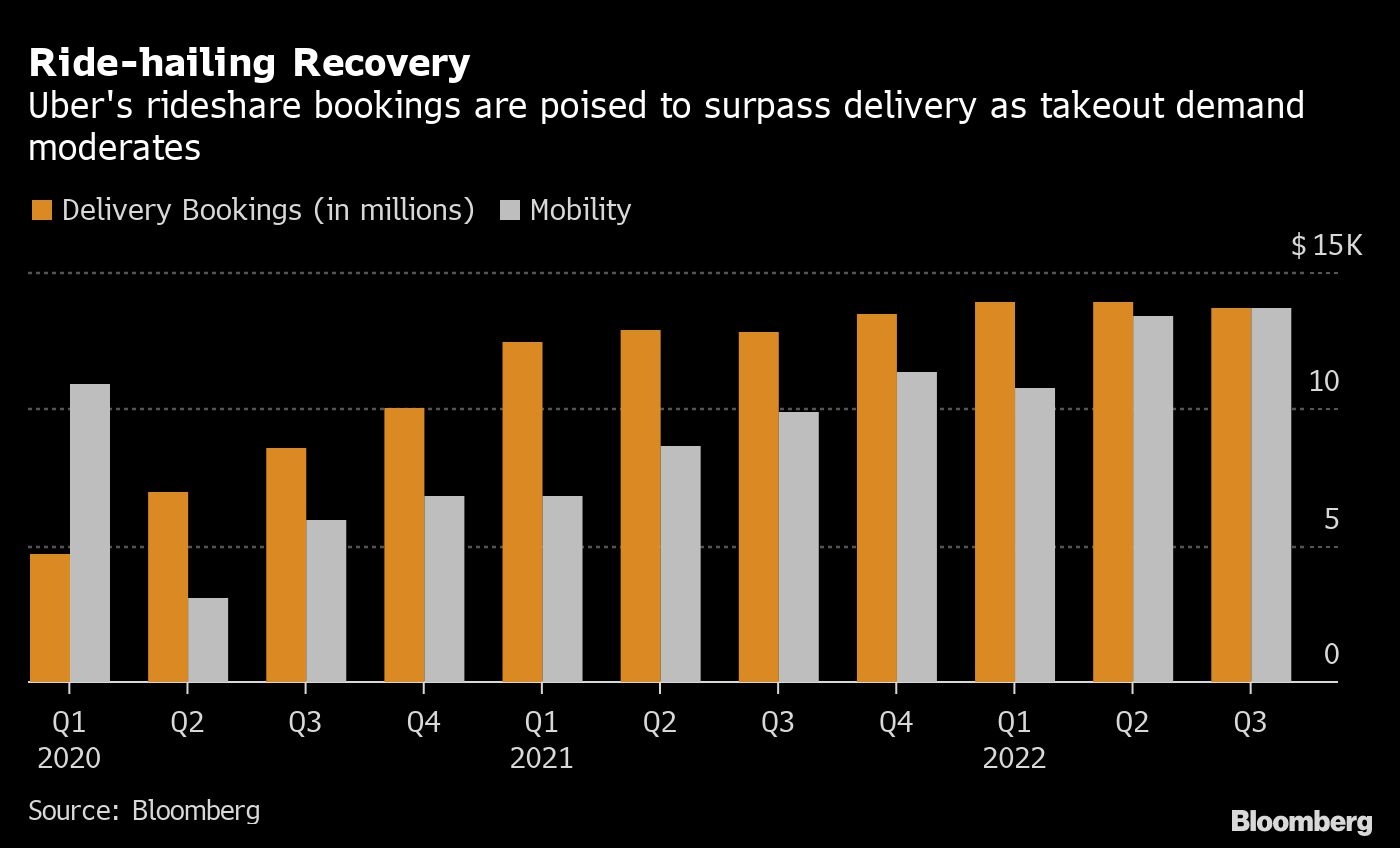Nov 1, 2022
Uber shares jump as strong ridership eases inflation worries
, Bloomberg News
Ross Healy discusses Uber
Uber Technologies Inc. rose after reporting revenue that beat analysts’ expectations as gains in ridership assuaged investor concerns that rising inflation would damp consumer spending.
Third-quarter sales increased 72 per cent to $8.34 billion, the San Francisco-based company said Tuesday in a statement. That exceeded the $8.1 billion analysts were expecting, according to data compiled by Bloomberg.
“Right now frankly we’re not seeing any signs of consumer weakness,” Chief Executive Officer Dara Khosrowshahi said in a conference call with analysts Tuesday. He added that strong ridership was driven by cities reopening, travel booming and a continued shift of consumer spending from retail to services. “October is tracking to be our best month ever for mobility and total company gross bookings,” he said.
The shares gained as much as 16.5 per cent in early New York trading, the most since August.
The company’s monthly active users rose to a new high of 124 million, with the number of people taking ride-share trips jumping 22 per cent in the third-quarter. However, customers are still not taking as many trips as they were pre-pandemic. “There is still significant runway to recover to pre-pandemic levels,” Khosrowshahi said.

Gross bookings, which encompass ride hailing, food delivery and freight, increased 26 per cent to $29.1 billion, slightly below the average estimate, which Uber attributed to the impact of foreign exchange fluctuations. Adjusted earnings before interest, tax, depreciation and amortization reached $516 million. Analysts, on average, projected $458.7 million.
Uber reported its ride-hailing driver base at the end of the period on Sept. 30 was “on par with September 2019 levels,” and the increased driver engagement continued into October. The improvement is a sign the company is moving past a protracted shortage of drivers that has also affected rival Lyft Inc., resulting in higher fares and wait times for customers. Both ride-hailing giants have spent millions to lure drivers back to their respective platforms and recruit new ones to meet resurgent rider demand.
After surging during much of the pandemic, Uber and other gig economy peers such as Lyft and DoorDash Inc. are navigating a challenging economy that includes US inflation rising to a 40-year high while the risks of a global recession loom. The uncertainty has weighed on spending by advertisers and consumers, hitting tech giants like Meta Platforms Inc. and Amazon.com Inc. The gloomy outlook remains a risk for Uber, whose ride-hailing and delivery services carry a premium that customers may view more as a splurge than a necessity as budgets tighten.
Uber’s food-delivery arm, Uber Eats, generated $13.7 billion in gross bookings during the quarter, a decline from the previous period, and missed the $13.9 billion analysts expected. The unit, which offers delivery across restaurants, groceries and alcohol, has grown to make up about 33 per cent of the company’s total revenue. Uber Eats initially benefited from the pandemic-induced boom in delivery and has more than doubled in size, based on bookings, from before Covid-19 emerged. The increased scale has allowed the delivery business to become more profitable, posting a record $181 million in adjusted earnings during the period.
“While the delivery category is one of the few ‘pandemic winners’ that continues to grow with a healthy top line, we welcome the newfound capital discipline amongst our peers,” Khosrowshahi said. “We will be measured with our investments, and will look to expand profitability while maintaining or growing our category position.”
Uber reached profitability on an adjusted basis for the first time in its history last summer and, earlier this year, Khosrowshahi pledged to reach $2 billion in free cash flow. One way the company plans to meet that target is by giving more attention to ads. In October, Uber launched a dedicated advertising arm to monetize its audience of 124 million monthly active users and tap a higher-margin revenue stream. The company said the business reached $350 million in run-rate revenue during the third quarter and affirmed its goal to reach $1 billion in ad sales by 2024.
The company’s freight unit completed an integration with Transplace, which it acquired last year, and reported revenue of $1.75 billion. Bookings and adjusted earnings for the division missed analysts’ estimates amid weaker demand, spot volumes and rates that affected the logistics sector, Uber said.
“The legwork will be done on the mobility side because of the higher take rates and profitability,” said CFRA analyst Angelo Zino. “Delivery may be lacking those strong pandemic numbers but now that driver supply has improved, that bodes well for profitability and cash flow metrics.”
Uber projected adjusted earnings before interest, tax, depreciation and amortization in the current quarter of $600 million to $630 million, beating estimates of $564.4 million. Gross bookings will be $30 billion to $31 billion in the period ending in December, in line with expectations.
The company recorded a net loss of $1.2 billion, or 61 cents a share, attributed in part to its equity stake in Didi Global Inc.



